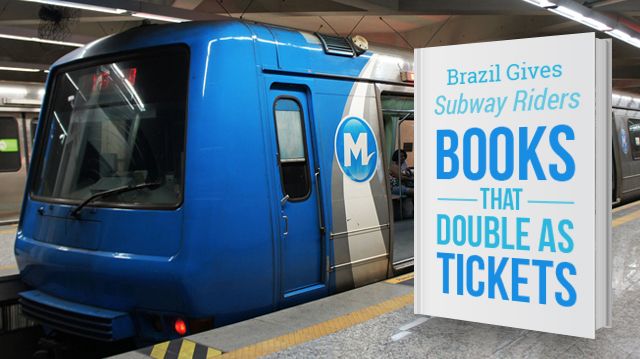Those who travel to work or any other destination via public transit know that there’s quite a bit of time to kill waiting for the bus, train or subway to arrive at its destination. While such commutes are certainly a greener choice than driving, they do require some patience.
One of the most beloved activities of people traveling by public transit is reading. Unless you suffer from motion sickness, it’s the perfect time to get immersed in a good book. In the Brazilian city of São Paulo, an awesome initiative known as Ticket Books handed out free books to subway passengers — books that doubled as tickets!
These books were published and distributed by Brazilian publisher L&PM. The company, which is Brazil’s biggest publisher of pocket books, collaborated with Agência Africa, who designed the covers with art reminiscent of subway maps. RFID cards were placed inside book covers so that they could be scanned at subway turnstiles.
According to media coverage by PSFK: “To celebrate World Book Day last April 23rd, L&PM gave away 10,000 books for free at subway stations across São Paulo. Each book came with ten free trips.”
What’s more, the Ticket Books were rechargeable so that riders could either keep using a favorite book as a ticket, or pass it along to a friend. Ten titles were published last year, including those by Pablo Neruda, F. Scott Fitzgerald, Agatha Christie, Sun Tzu, Sir Arthur Conan Doyle, William Shakespeare and Charles M. Schulz.
With such a wide range of authors, subway riders were almost sure to find a book they were interested in.
The importance of Ticket Books’ campaign did not go unnoticed. Three trophies were awarded to this project during the Cannes Lions Festival: Silver Lions in the “Promo” and “Outdoor” categories, and a Bronze Lion in the “Design” category. As Brazilians only read two books each year, on average, campaigns such as this one could help boost that number significantly.
Reading, besides being thoroughly enjoyable for many people, has a number of health benefits, both physical and mental. As far as physical benefits, Kjersti Lundetræ at the University of Stavanger’s Reading Centre explains: “Advice on nutrition, healthy diet and physical activity is increasingly communicated through newspaper and magazine articles and on the internet. We receive a great deal of information by reading. It’s conceivable that certain people miss out on important health advice because they read poorly and seldom.” This concept applies to books concerning health and nutrition, as well.
As far as mental health, research shows that reading, and doing other mentally stimulating activities, may help to prevent cognitive decline. The authors of a 2013 article published in the journal Neurology wrote: “More frequent cognitive activity across the life span has an association with slower late-life cognitive decline that is independent of common neuropathologic conditions.”
Along with those important benefits, reading a good book can metaphorically transport you to another world. This can greatly help to reduce stress, and we can learn a lot about the human condition, and the human relationship with the environment, by immersing ourselves in literature.
Wouldn’t it be wonderful to see programs such as Ticket Books used in subways, and even bus terminals, across the United States?
—Tanya Rakhmilevich
Tanya is a writer at The Alternative Daily with a passion for meditation, music, poetry, and overall creative and active living. She has a special interest in exploring traditional Eastern remedies and superfoods from around the globe, and enjoys spending time immersed in nature.
Sources:
http://www.openculture.com/2016/01/brazil-gives-out-books-that-double-as-subway-tickets.html
http://www.psfk.com/2015/11/books-double-as-subway-tickets-brazil-lpm-editores.html
http://ticketbooks.com.br
http://www.lpm-blog.com.br
http://www.uis.no/research-phd-education/research-news/reading-is-good-for-your-health-article80454-10738.html
http://www.neurology.org/content/81/4/314

